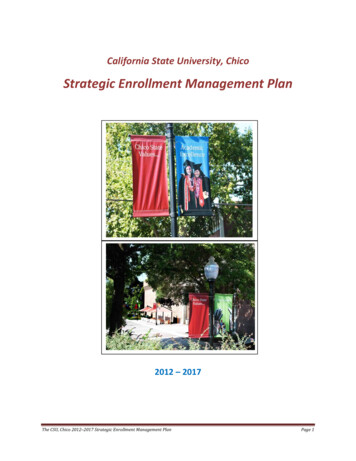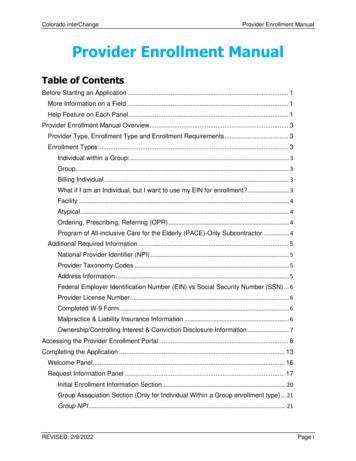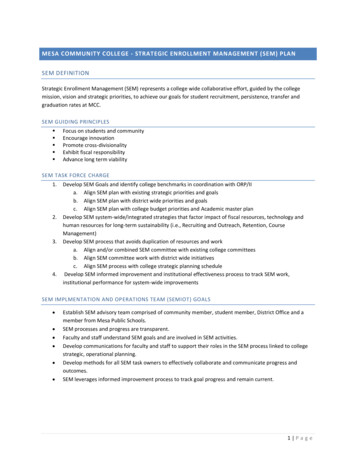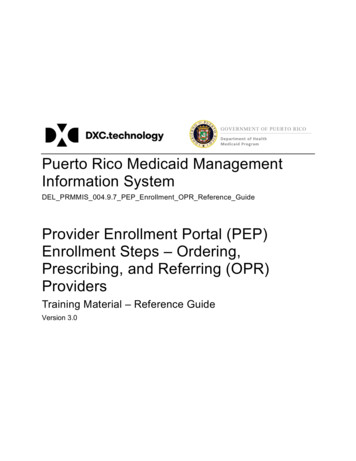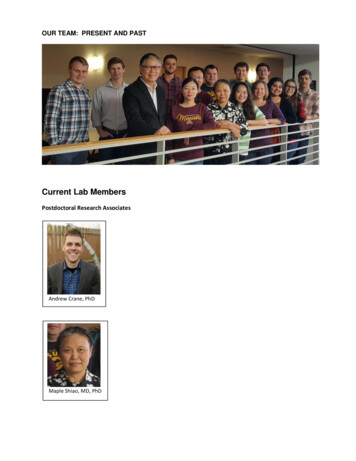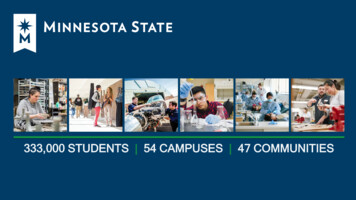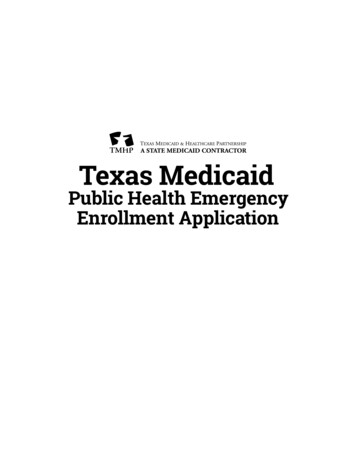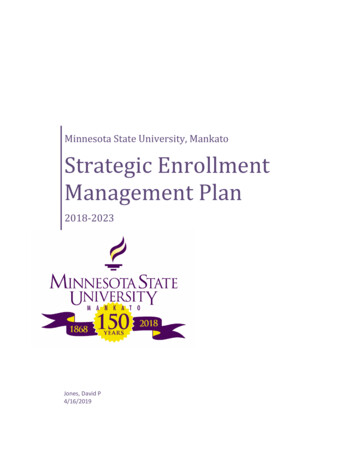
Transcription
Minnesota State University, MankatoStrategic EnrollmentManagement Plan2018-2023Jones, David P4/16/2019
1I.Introduction and FocusThe purpose of a strategic enrollment management plan is to provide an intentional approach to theidentification, recruitment, retention, and completion of students in order for Minnesota StateUniversity, Mankato to fulfill its mission and goals. The following strategic enrollment managementplan will owe much of its success to the institution’s ability to refine current recruitment and retentionpractices, while developing new strategies to achieve our goals. Where the last Strategic EnrollmentManagement (SEM) Plan focused strictly on measures of retention, graduation, and enrollmentgrowth, the new SEM will have a similar focus, however it will be framed through the lens of StudentSuccess.The SEM Plan contains three Goals targeting undergraduate and graduate students:1. Increase student success of first-year students.2. Increase the number of students completing a degree.3. Increase total student enrollment.II.Reason for a Minnesota State University, Mankato PlanLike any journey with a clear destination, our SEM plan identifies enrollment goals and the strategies tohelp us get there. Since the creation of the past SEM plan, Minnesota State Mankato has tackled manyenrollment-related challenges through intentional planning efforts, specific initiatives, and theadoption of a new University Strategic Plan. These documents, projects, and efforts include theIntegrated Academic Master Plan, AASCU’s Reimagining the First Year Experience Project, theInternational Student Enrollment Plan, and the University’s Strategic Goals and Objectives 2016-2021.Additionally, our campus has increased our focus on enrollment through formal meeting agendas,informal conversations, and our re-titled Enrollment Operations Group. The Enrollment OperationsGroup consists of experts in their fields who work in enrollment related offices and departments.Enrollment Operations Group:Director of Undergraduate Admissions, Brian Jones (Convener)Vice President for Student Affairs and Enrollment Management, Dr. David JonesAssistant Vice President for Undergraduate Education, Dr. Ginger Zierdt (Dr. Teri Wallace)Director of Student Financial Services, Jan MarbleRegistrar, Marcius BrockDirector of New Students and Family Programs, Nikki Stock
2Director of the Career Development Center, Pam WellerDirector of Financial Aid, Tyler HeuDirector of Graduate Studies, Chris MickleDirector of the Kearney Center for International Student Services, Jacy FryInterim Director of O.A.S.I.S., Sergio AguilarDirector of Residential Life, Cindy JanneyDirector of Advising, Dr. Allen ThompsonIn the Spring of 2018, President Davenport, with the support of the collective bargaining units oncampus, created a Summer Enrollment Management Group to tackle big questions related to ourUniversity’s overall enrollment challenges. This workgroup consisted of the following members of ourcollective bargaining units, the Provost and Senior Vice President, the Interim Associate Vice Presidentof Research & Dean of Graduate Studies, and a representative from Information Technology Solutions.The Provost and the Vice President for Student Affairs & Enrollment Management served as coconveners.Dr. David Jones, Vice President for Student Affairs & Enrollment Management, Co-ConvenerDr. Marilyn Wells, Provost and Senior Vice President, Co-ConvenerDr. Stephen Stoynoff, Interim Associate Vice President of Research & Dean of Graduate StudiesDr. Emily Stark, Psychology, Faculty AssociationDr. Rama Mohapatra, Geography, Faculty AssociationCraig Sanderson, Student Financial Services, MSUAASFMike Altomari, Concurrent Enrollment and PSEO, MSUAAASFJill Krosch, University Extended Education, AFSCMEPatsy Lueck, International Student Office, AFSCMECathy Hughes, Information Technology SolutionsIn addition to the Enrollment Operations Group and the Summer Strategic Enrollment ManagementGroup, the creation of this plan included input or consultation with members attending the ClassifiedMeet and Confer, MSUAASF Meet and Confer, Faculty Association Meet and Confer, Planning Sub-
3Meet, Assessment and Evaluation Sub-Meet, G-CAP, Council of Deans, table attendees as thePresident’s 2018 Retreat at Gustavus Adolphus College, and the President’s Cabinet.III. Environmental Enrollment Changes and Opportunities EnvironmentThe state, national, and international higher education continues to be impacted by demographic shifts,shrinking public support, a healthy economy, and geopolitical politics. Any one of these changes has anindependent impact on institutions of higher education, but the collective has the power to significantly changethe landscape of higher education.According to the Minnesota Office of Higher Education, the state of Minnesota continues to experience adecline in the enrollment of collegiate students. From 2010 (309,319 undergraduates) to 2017 (244,449undergraduates) there has been a 21% decline in enrolled undergraduates in Minnesota postsecondaryinstitutions. Over this same period, there has been a decline of 3,592 graduate students in Minnesota. There issignificant growth in the number of high school students taking college credits over this same period. From2010 (23,591 high school students) to 2017 (44,435 high school students) there has been a 47% increase inenrolled high school students in higher education, further reinforcing that higher education may be entering aperiod of significant change.On a national level, the Western Interstate Commission for Higher Education (WICHE) 2017 annual reportKnocking at the College Door, projects a period of stagnation in the overall number of high school graduatesproduced in the U.S. from 2018-2025. The U.S. Department of Education projection mirrors the WICHEprojection over this same time period. This period will also reflect a decline in the White student population andgrowth in the number of non-White high school student graduates. Hispanics and Asian/Pacific Islanders willdrive the greatest growth nationally. Add these changes to a nation experiencing a prolong period of economicgrowth, a bull market since March, 2009, and a jobless rate close to an 18-year low, and you have a populacethat is not in need of immediate retraining. The nation’s, including Minnesota’s, two-year institutionsexperience declines in enrollment during economic growth periods.Higher education in the U.S., continues to be a focus of impassioned headlines regarding its value and support.Terry Hartle, Senior Vice President for Government Relations and Public Affairs for the American Council onEducation (ACE) recently identified, “that the public is looking for four outcomes: that students can completetheir degree, they can do so timely, with a minimum of debt, and find success afterward.” From the shifting ofthe cost of public higher education from the state to the family, to the growth of new delivery methods like fullyonline programs, the U.S. higher education institutions are in period of turbulence.Beyond the U.S., there have been changes in the international market and our nativist political approach tocertain countries has continued a slight decline in international student enrollment. The growth of Australianand United Kingdom institutions in the international market, as well as the growth of national education systemsin developing nations, has directly affected partnerships and international student enrollment in the U.S.According to the Associated Press, international enrollment figures for 2017-2018 suggested a decline of almost
47% from the peak year of 2016-2017 (900,000 international students). The decline in the number of Visas is justshy of 40% over the same period.Minnesota State University, Mankato Strategic Directions 2016-2021In 2016, Minnesota State Mankato put forth six strategic action steps to transform our University. These are:1.2.3.4.5.6.Enhancing Student Success and CompletionElevating Distinction and Academic AchievementAdvancing a Culture of Evidence and Innovative Organizational DesignsExpanding Regional and Global ImpactLeading Equity and Inclusive ExcellenceLeveraging the Power of Partnerships and CollaborationMinnesota State Colleges and Universities (Minnesota State) Strategic FrameworkDevinder Malholtra, Chancellor of the Minnesota State Universities and Colleges System, introduced newaspirations for the system in March, 2018. These include: Focus on student success Focus on diversity, equity, and inclusion in delivering education Ensure long-term financial sustainability of our colleges and universitiesSummary of Changes and OpportunitiesThe environment in which we recruit and retain students is changing. The number of high school graduates isdeclining, this declining population is growing more diverse, and our traditional out-of-state markets areexperiencing the same. The enrollment figures and demographic shifts shared above will be significant factorsin enrollment management planning.Asking the Big Enrollment QuestionsAs referenced earlier, President Davenport identified our need to ask the big questions. The Summer StrategicEnrollment Management Group asked the big questions about student success through the student lens. As acampus, we wish to move from an interventionist model, which assumes that students have characteristics,which predisposes them to a certain level of performance, to a student analytics model that focuses onimproving existing processes for student success. When you look at our performance over the past twelveyears, it is readily apparent that we need to think and act differently, if we wish to have different results.Fall ’02Fall ‘16First-Year Student Retention Rate76%73%4-Year Graduation Rate16%22%6-Year Graduation Rate51%50%“When a flower doesn’t bloom you fix the environment in which it grows, not the flower.”-Alexander Den Heijer,
5These big questions spurred great discussion and debate. The ideas raised informed the strategies for thisstrategic enrollment management plan. The Big Questions we asked:1.2.3.4.What are our systems and processes that produce at-risk students?How do you think students view our registration and advising processes?How do we better match the needs, desires, and expectations of our students?What do successful students do at MSU?The results of these questions can be found in Appendix A.IV. Elements of an Enrollment Management PlanGoalsGoals are the overall conclusion or accomplishment that the plan is hoping to achieve. Goals should be specific,quantifiable, and measurable.StrategiesStrategies are the overall methods that we will use to accomplish the goals.Action PlansAction Plans describe how the strategies will be accomplished. Actions Plans include who is responsible, whatthe action is, a cost for the action, a timeline for the action, and a measurable outcome.V. Strategic Enrollment Management MeasuresWhere the last SEM Plan drew upon statewide competitors for numerical goals for measures and aspirationalgoals for improvement and growth, this SEM Plan will root its goals based on the University’s Strategic Goals andObjectives 2016-2021 of Enhancing Student Success and Completion and Advancing a Culture of Evidence andInnovative Organizational Designs. More specifically, this SEM Plan will set to surpass the 75th percentile of ourIntegrated Postsecondary Education Data System (IPEDS) Peer Group [https://nces.ed.gov/ipeds/] for thefollowing three goals. This would place us in the top quartile of our peers. Not all of our measures havecomparable data with our IPEDS Peer Group. In cases where that exists (noted with *), an improvement overthe most recent five-year average for that measurement is the goal. The 10 IPEDS Peers listed below wereselected by the University’s Assessment and Evaluation Sub-meet from the 30 Peers suggested by IPEDS byvirtue of the similarities among the institutions in 2012.Our IPEDS Peer Group from the 2016 IPEDS Data Feedback Report included: California State University-Chico (Chico, CA)Eastern Kentucky University (Richmond, KY)Grand Valley State University (Allendale, MI)Missouri State University-Springfield (Springfield, MO)Saint Cloud State University (Saint Cloud, MN)Southern Illinois University-Edwardsville (Edwardsville, IL)University of Northern Iowa (Cedar Falls, IA)Western Illinois University (Macomb, IL)
6 Western Kentucky University (Bowling Green, KY)Western Washington University (Bellingham, WA)VI. Enrollment Management GoalsMinnesota State University, Mankato has identified the following three goals based on our University StrategicPlan, Integrated Academic Master Plan, Re-Imagining the First Year of College AASCU project, Minnesota StateSystem Strategic Framework, shifting state demographics, historical trend data, and our aspirations. Thefollowing goals and measures will use 2016 graduation, retention, persistence, and enrollment rates reported inFY2017 as the foundation for measurement.Goal One—Increase Student Success of First Year Students.1.1 Increase the retention rate of new students from first fall to second fall (first-time)First Time Full Time Student Retention Rate at 75th Percentile 84% (Mankato 74%)MankatoPeer 75thFall 201273.4%83%Fall 201373.0%83%Fall 201473.6%84%Fall 201572.0%84%Fall 201674.3%84%Transfer Full Time Student Retention Rate *Fall 201271.3%Fall 201374.1%Fall 201476.1%Fall 201575.9%Fall 201670.3%1.2 Increase course completion rate in the first term of enrollment (first-time and transfer)First Time Student Course Completion Rate *Fall 201288.8%Fall 201387.9%Fall 201488.6%Fall 201587.7%Fall 201690.3%Fall 201587.2%Fall 201686.0%Transfer Student Course Completion Rate *Fall 201285.8%Fall 201385.8%Fall 201488.5%1.3 Increase the percentage of students in academic good standing after first term of enrollment (first-time andtransfer)First Time Student Good Academic Standing Rate *Fall 201282.2%Fall 201381.5%Fall 201481.1%Fall 201581.4%Fall 201685.6%Transfer Student Good Academic Standing Rate *Fall 201280.9%Fall 201379.4%Fall 201482.9%Fall 201582.4%Fall 201680.0%
71.4 Decrease first fall to second fall retention rate gap between historically underrepresented and Whitestudents (first-time and transfer)First Fall to Second Fall First Time Full Time Retention Rate Gap *Fall 2014Fall 2015Fall 2016Mankato Fall 2012 Fall 73.9%13.360.6%73.9%First Fall to Second Fall Transfer Full Time Retention Rate Gap *Fall 2014Fall 2015Mankato Fall 2012 Fall 5.8%7.369.9%77.2%6.969.0%75.9%Fall 20165.265.3%70.5%Goal Two—Increase the number of students completing a degree.2.1 Increase the four-year completion rate (first-time and transfer)First Time Full Time Student 4 yr. Completion Rate at 75th Percentile 34% (Mankato 25%)MankatoPeer 75thFall 200622%31%Fall 200721%33%Fall 200822%31%Fall 200922%37%Fall 201025%34%Transfer Full Time Student 4 yr. Completion Rate at 75th Percentile 58% (Mankato 53%)MankatoPeer 75thFall 200651%Fall 200749%Fall 200854%Fall 200949%Fall 201053%58%2.2 Increase the six-year completion rate (first-time and transfer)First Time Full Time Student 6 yr. Completion Rate at 75th Percentile 66% (Mankato 51%)MankatoPeer 75thFall 200652%66%Fall 200749%66%Fall 200850%64%Fall 200949%67%Fall 201051%66%Transfer Full Time Student 6 yr. Completion Rate at 75th Percentile 66% (Mankato 61%)MankatoPeer 75thFall 200663%Fall 200762%Fall 200864%Fall 200961%Fall 201061%66%
82.3 Decrease the four-year completion rate gap between historically underrepresented and White students(first-time)First Time Full Time Student 4 yr. Completion Rate Gap at 75th Percentile 9% (Mankato 16%)Fall 2011Fall 2012Fall 2013Mankato Fall 2009 Fall 2.6%16.19.8%25.9%Transfer Full Time Student 4 yr. Completion Rate Gap *Fall 2011Fall 2012Mankato Fall 2009 Fall 53.4%7.442.9%50.3%15.510.4%25.9%Fall 201317.336.4%53.7%2.4 Decrease the six-year completion rate gap between historically underrepresented and White students (firsttime)First Time Full Time Student 6 yr. Completion Rate at 75th Percentile 7% (Mankato 25%)Fall 2009Fall 2010Fall 2011Mankato Fall 2007 Fall 0%51.1%Transfer Full Time Student 6 yr. Completion Rate *Fall 2009Mankato Fall 2007 Fall 1.3%25.429.5%54.9%24.726.4%51.1%Fall 201013.150.9%64.0%Fall 20113.559.8%63.3%2.5 Decrease average time to degree completion (first-time and transfer)First Time Student Average Time to Degree Completion (years) 7Transfer Student Average Time to Degree Completion (years) 4Fall 201515,313Fall 201615,165Fall 201714,742Goal Three—Increase total student enrollment.3.1 Increase total student headcount enrollmentFall 201315,426Fall 201415,387
93.2 Increase undergraduate student enrollment/New student enrollment (first time and transfer).UndergradTotalFall 201313,467Fall 201413,395Fall 201513,269Fall 201613,192Fall 201712,796NewStudentFirst-TimeFall 2013Fall 2014Fall 2015Fall 2016Fall l 2013Fall 2014Fall 2015Fall 2016Fall 20171,0911,0991,0781,0721,0203.3 Increase graduate student headcount enrollment.Fall 20131,959Fall 20141,992Fall 20152,044Fall 20161,973Fall 20171,9463.4 Increase historically underrepresented student enrollment. (Students of Color)Fall 20132,066Fall 20142,121Fall 20152,292Fall 20162,375Fall 20172,3723.5 Increase international student enrollment (undergraduate and graduate).Fall 2013881Fall 20141,004Fall 20151,110Fall 20161,173Fall 20171,3583.6 Increase Post-Secondary and Concurrent Enrollment student enrollment.Fall 2013722Fall 2014808Fall 2015757Fall 2016786Fall 2017572Summer20165,442Summer20175,6173.7 Increase summer enrollment (undergraduate and 5,6083.8 Increase 100% online degree program enrollment (undergraduate and graduate)Fall 2013205Fall 2014244Fall 2015280Fall 2016259Fall 20172813.9 Increase continuing education program enrollment (undergraduate and graduate).Fall 20132,053Fall 20141,100Fall 20152,478Fall 20164,466Fall 20177,0533.10 Increase certificate program enrollment (undergraduate and graduate).Fall 2013227Fall 2014244Fall 2015241Fall 2016302Fall 2017300
10VII. Enrollment Management StrategiesWithin the structure of Minnesota State Mankato, there is no individual team, group, committee, task force,sub-meet, or other body tasked with the role of receiving, discussing, exploring, and making recommendationson University efforts, policies, practices, and issues that directly affect student success. With the adoption ofthis SEM Plan, it is recommended to create a formally recognized group to serve as the body to address issuesrelated to student success. In Appendix B is a suggested approach to creating the Student Success Roundtable,patterned after the existing Technology Roundtable.With established goals for our strategic enrollment management plan, we must turn towards the specificstrategies to improve our student success measures. Our University has recently identified new StrategicDirections which will provide a focus on our specific efforts.VII. Enrollment Management Action PlansGoal1. IncreaseStudent Successof First YearStudentsObjectiveRevise majordeclaration creditrequirements tomatch semestersystem.Implement resultsof the NewStudentCommunicationAudit completedin 2017-2018Create process topackage studentsfor financialsupport.Providepreliminaryfinancial aid awardletters earlier.Implement theAcademic AdvisingTask Force Reportrecommendationsin the IntegratedLead(s)StartEndNotesTBDDirector ofSeptember, In Progress.University2018Admissions andAssistantDirector forStudent Success&CommunicationsDirector ofFinancial AidDirector ofFinancial AidAssociate VicePresident forUndergraduateEducationSeptember, In Progress.2018Implement theAcademicAdvising TaskForce Reportrecommendationsin the Integrated
112. Increase theNumber ofStudentsCompleting aDegreeAcademic MasterPlan.Create studentsuccess behavioraland/or creditexpectations ofstudents whoreceive Universityscholarships.Increase usage ofMavConnect(Starfish) amongadvisors,professors, andstudents.Create a solelyonline studentonline orientation.Improve speed ofcourseequivalencydecisions forTransfer students.ObjectiveImplement acommon bellschedule.Academic MasterPlan.Director ofScholarshipsAssistantAugust,Director for2018Student Success&CommunicationsIn progress.AssistantDirector ofOrientationRegistrar?August,2018In progress.Lead(s)StartVice Presidentfor Finance andAssociate VicePresident forInstitutionalResearch,Strategy, andEffectivenessRegistrarDevelop auniversal MajorDeclaration,Change, andRecording process.Review andTBDconfirm or revisecurriculumbarriers tocompletion likeprogram GPAEndSeptember, In Progress.2018Notes
12requirements,minimumgraduation GPA,etc.ImplementReimagining theFirst YearExperience TaskForcerecommendations.Automatedynamic studentdegree maps.Expand highimpact learningpractices likehonors, research,globalexperiences, studyabroad,internship,cooperativeexternships, etc.Leverageinformation in thelearningmanagementsystem (D2L) todriveinterventions forstudents at risk.Provide afterhoursstudent supportservices.Increase staffsupport forveteran and activemilitary students.Provide supportservices likecounseling,accessibilityresources,tutoring, etc. tomatch thedemand andneeds of students.Associate VicePresident forUndergraduateEducationSeptember, In Progress.2018Minnesota StateSystemUsing D2L as asolution.TBDInstitutionalResearch, Data,ITS, AssistantDirector forStudent Success&CommunicationsTBDDean ofStudentsDirector of theCounselingCenter, Directorof AccessibilityServices, andDirector of theTutoring CenterOctober,2018In Progress
133. IncreaseTotal StudentEnrollmentProvide mobilefriendlyinformation onstudent supportservices tostudents.ObjectiveITSLead(s)StartEndCreate a GraduateEnrollment Plan.Associate VicePresident forResearch andGraduate DeanDean ofInstitutionalDiversityJanuary,2018In ProgressAugust,2018In ProgressVice Presidentfor Finance &Administrationand VicePresident forStudent Affairs& dationsof the University’sDiversity andInclusion Plan tosupport studentenrollmentgrowth.Review tuitionrates including:tuition band,international, nonresident, andonline at theundergraduateand graduatelevels.Review financialpractices andpolicies that affectour ability toregister, keepstudentsregistered andenrolled.Establish aretentionscholarship poolof funds for recruitback efforts.Develop a PostSecondaryEnrollment Option(PSEO) andTBDVice Presidentfor UniversityAdvancementand Director ofScholarshipsAssistantDirector forPSEO andConcurrentNotes
14ConcurrentEnrollmentenrollment plan.Apply bestpractices tostudentrecruitment andretentionEnrollmentProgramsDirector ofUniversityAdmissions,Director of NewStudent &FamilyPrograms, andDirector ofAdvisingAugust,2018In progress.
15Appendix A.Big Enrollment QuestionsOur Big Questions:1.2.3.4.What are our systems and processes that produce at-risk students?How do you think students view our registration and advising processes?How do we better match the needs, desires, and expectations of our students?What do successful students do at MSU?What are our systems and processes that produce at-risk students? Professional development for better advisingToo many course choicesHard to find information on MSU websiteAdvisors need training:o General Edo Transfer StudentsBroader use of Starfish to retain student communicationWhat is an appropriate advising load to have successful advising?Burden is on student to apply to graduate/if missing creditsCatch students who commence and don’t graduateIncongruence between MNTC and MSU requires “C” in math and EnglishNeed better student resources/expectations of learning strategiesMath 98 delays progressGrading policy allows for inconsistencyGeneral Ed is tough to understand across goal areas“8-2” ruleAdjuncts and Teaching Assistants teach lots of 100 and 200 coursesIncrease knowledge of resources for students (faculty and staff also)Courses switched from traditional class to onlineCourses offered in enough sections, right times and right semesterLack of common bell scheduleInternational students can’t take online coursesTruth in Advertising on program admission (major declaration)Non-academic challenges (alcohol, hunger, money, etc.)Opportunities in Learning CommunitiesCampus vs legal behavioral sanctionsSIS allows student choices that deter successful progress
16Strategic Enrollment Management Planning Table TopicPresident’s 2018 Retreat at GustavusFirst RotationWhat are our systems and processes that produce at-risk students? Loss of Agile GradLimited Nursing major opportunitiesIntentional early advisingClass availability impacts what a full load iso Look at changing full banded tuition to promote taking 15 creditsWhat is the role of a gap year?Mavericks Success Programo Do advisors see Starfish info?Hall Directors follow up on “D” and “F” gradesDoes Residential Life terminate contracts too fast?Timely tuition decisionsHow do you think students view our registration and advising processes? Culture of sink or swim (no worries on roadblocks)Student quit at roadblocksCampus nomenclature can be confusingLack of useful information for parents to support students {order a meal for 3 (package)}Maximize student data to influence changes in processSend Deans on a run to have a have course transfer transcript requestTough to apply for graduationStudents can learn our bureaucracyo Should they?Look at deposits. Really needed?Too many silosBe more efficient to benefit studentsCan maintain program quality and eliminate roadblocksA secret student shopper experienceCatalog needs to reflect course offerings and timingCan take students up to three semesters to get ENG 101Need mandatory AdvisingRegistration – change to favor lower class students firsto Late admits end up with writing intensive coursesMSU needs to initiate transfer evaluation
17 o More responsibility from studentso Substitutes come late in their junior/senior yearChanging majors puts students behind on degree pathsMaps aren’t being usedDevelop a student contract with tasks to graduate in four yearsHow do we better match the needs, desires, and expectations of our students? Delay in financial aid awardso Are students getting the right advice at the right timeStudent challenge to pay for schoolStudents don’t always know when they have financial aidNeed better adherence to degree mapNeed a common bell scheduleo Tough for students to navigate timesHow to get student help/information when they need itHow to maximize information fair during OrientationSystems need to be more protectiveo Partner with K-12 and community collegeCreate an IMLI (Intensive Math Learning Institute)More Counseling Centero Triage approacho Online form for intake and scheduling?o ConfidentialSecond RotationWhat are our systems and processes that produce at-risk students?Removing barriers – the risk is not coming up with new ideas; it is what do we let go of?Advising and registration issues Need earlier advising for students, especially for students who apply to competitive programs such asNursing.Students aren’t able to get into the classes they need so may only take 12 credits.MSP advising – good program, but do the GA advisors have access to grades, etc.? This should improveas D2L moves to the cloud.Family responsibilities sometimes get in the way of student success and completion – students sometimes taketime off to help with family stuff. For example, a student may go back to get a job if someone else in the familygets laid off.
18Tuition is decided by the system office and is uniform for all Universities rather than based on what eachUniversity is trying to accomplish.How do you think students view our registration and advising processes?There is a culture of “sink or swim” on campus. Culture change is important to removing obstacles. Every time astudent hits a block, it’s an opportunity for them to stop out.Institutional Intelligence – knowing all of the processes and procedures and they work (or don’t work) togetherand how that impacts the student experience. We need to break down silos because some of us are doing thesame things and we don’t know it; we could streamline or learn from each other. As a result, students arelearning how to navigate bureaucracy rather than the skills we really want them to learn, like critical thinking.Idea was shared to put a staff person through the process to see what it takes to be successful.Advising and registration issues ENG 101 availability. Some students can’t get into it until their 3rd or 4th semester.Courses are not offered in the order that they’re showing on the academic maps.We should have mandatory advising – don’t let students “opt in” to advising.We should reserve specific courses for new 1st year and transfer students. Often, the last studentscoming to Orientation are the most vulnerable populations yet they get the last choice in courses. Someend up enrolling in writing intensive courses before taking ENG 101—this sets them up for failure.The student has to initiate course substitution/equivalency process. When onboarding, we should havea dedicated staff person to do that for students. There is a lot of run-around for the students in thisprocess.Question asked about student expectation/plan to graduate in 4 years vs 5 years? Reasons for not beingable to graduate in 4 years includes course availability and s
Minnesota State University, Mankato Strategic Directions 2016-2021 In 2016, Minnesota State Mankato put forth six strategic action steps to transform our University. These are: 1. Enhancing Student Success and Completion 2. Elevating Distinction and Academic Achievement 3. Advancing a Culture of Evidence and Innovative Organizational Designs 4.
